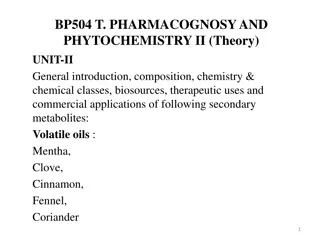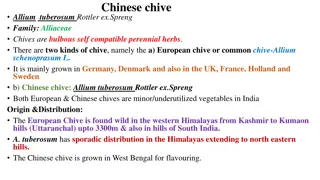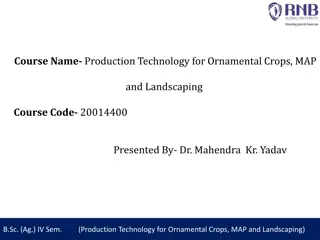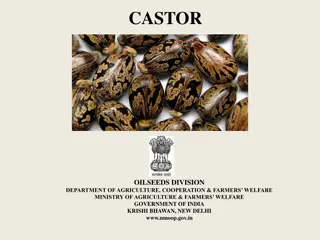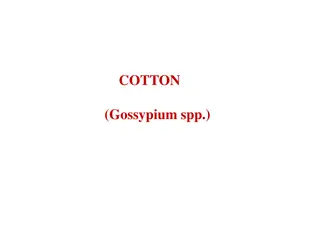Safflower: Overview of Cultivation and Production Worldwide
Safflower, scientifically known as Carthamus tinctorius, is a versatile oilseed crop cultivated in various countries. It is a day-neutral plant sensitive to temperature, with optimal flowering conditions between 24°C and 32°C. The plant is highly branched, thistle-like, and cross-pollinated. Globally, safflower is grown in over 20 countries, with India having significant coverage but lower yields compared to other producers. Detailed statistics show the area, production, and yield of safflower in major cultivating nations.
Download Presentation

Please find below an Image/Link to download the presentation.
The content on the website is provided AS IS for your information and personal use only. It may not be sold, licensed, or shared on other websites without obtaining consent from the author.If you encounter any issues during the download, it is possible that the publisher has removed the file from their server.
You are allowed to download the files provided on this website for personal or commercial use, subject to the condition that they are used lawfully. All files are the property of their respective owners.
The content on the website is provided AS IS for your information and personal use only. It may not be sold, licensed, or shared on other websites without obtaining consent from the author.
E N D
Presentation Transcript
SAFFLOWER OILSEEDS DIVISION DEPARTMENT OF AGRICULTURE, COOPERATION & FARMERS WELFARE MINISTRY OF AGRICULTURE & FARMERS WELFARE GOVERNMENT OF INDIA KRISHI BHAWAN, NEW DELHI www.nmoop.gov.in
BOTANICAL DESCRIPTION Family : Asteraceae Common Name : Kusum Scientific Name: Carthamustinctorius L. Origin: Area bounded by Eastern Mediterranean and Persian Gulf, encompassing southern parts of former USSR, western Iran, Iraq, Syria, Southern Jordan and Israel Turkey,
SEASON AND CLIMATE Safflower is more or less a day-neutral plant but is thermo sensitive Crop is tolerant to low temperature at seedling and vegetative stages Safflower comes up better in relatively drier areas Frequent and prolonged rains and heavy dew at flowering stage adversely affect pollination and seed development Optimum temperature for flowering is between 24 C and 32 C, however, adequate soil moisture reduces the adverse effect of high temperature High temperature also tends to decrease seed weight
CROP DESCRIPTION Plant is highly branched, herbaceous, thistle-like Plant height varies from 30-150 cm Leaves are spiny or non-spiny Inflorescence is broad, flat or slightly curved and densely bristled It is a cross pollinated crop
GLOBAL SCENARIO Safflower is cultivated in more than 20 countries on an average area of 9.55 lakh ha with a production of 8.09 lakh tonne and productivity of 846 kg/ha (2012-13 to 2014-15) India has the larger coverage but lower yield among the producing countries major safflower
AREA, PRODUCTION AND YIELD OF SAFFLOWER IN MAJOR GROWING COUNTRIES (A-Area in lakh ha; P-Production in MT; Y-Yield in kg/ha) 2012-13 2013-14 Country 2014-15 Sr. No A P Y A P Y A P Y 1 Kazakhasthan 2.44 1.27 522 2.76 1.75 633 3.1 1.96 632 2 India 1.78 1.45 815 1.5 1.09 727 1.4 1.13 807 3 Mexico 1.73 2.58 1489 0.81 0.92 1140 1.15 1.44 1260 4 Argentina 1.62 1.08 671 0.88 0.5 569 0.95 0.66 699 5 USA 0.65 0.79 1218 0.69 0.95 1381 0.69 0.95 1373 World 9.65 8.42 873 8.90 7.18 807 10.10 8.68 859 Source: Oilseeds Statistics: A Compendium - 2015, ICAR-Institute of Oilseeds Research, Hyderabad
AVERAGE AREA (LAKH HA), OF MAJOR SAFFLOWER GROWING COUNTRIES (2012-15) 0.68 1.15 2.77 Kazakhasthan India Mexico 1.23 Argentina USA 1.56
AVERAGE PRODUCTION (LAKH MT) OF MAJOR SAFFLOWER GROWING COUNTRIES (2012-15) 0.79 1.27 Kazhakstan 1.08 India 1.45 Mexico Argentina 2.58 USA
NATIONAL SCENARIO Maharashtra and Karnataka are major safflower growing contribute more than 90% of India s production States, which An area of 1.44 lakh ha was covered under safflower during 2015-16 as against average area of 2.79 lakh ha during 11th Plan
AREA, PRODUCTION AND YIELD OF SAFFLOWER IN INDIA (AVERAGE 2013-16) (A-Area in lakh ha; P-Production in lakh MT; Y-Yield in Ql/ha) Sr. No. State A P Y 1 Andhra Pradesh 8.75 0.04 0.04 2 Karnataka 7.83 0.40 0.34 3 Madhya Pradesh 5.75 0.20 21.00 4 Maharashtra 3.75 0.87 0.37 5 Telangana 4.17 0.03 0.02 All India 5.33 1.44 0.89 * Fourth Advance Estimates (2015-16) Source: Directorate of Economics and Statistics, Ministry of Agriculture & Farmers Welfare, New Delhi.
AREA, PRODUCTION AND YIELD OF SAFFLOWER IN INDIA (2013-16) 7 2013-14 6 5 4 2014-15 3 2 2015-16 1 0 Area (lakh ha) Production (lakh MT) Yield (ql/ha)
STATE WISE AVERAGE AREA (2013-14 TO 2015-16) UNDER SAFFLOWER IN LAKH HA 0.05 0.04 Andhra Pradesh 0.43 Karnataka Madhya Pradesh 1.02 0.20 Maharashtra Telanagana
STATEWISE AVERAGE PRODUCTION (2013- 14 TO 2015-16) OF SAFFLOWER IN MT 0.03 Andhra Pradesh 0.04 Karnataka 0.34 0.37 Madhya Pradesh Maharashtra 0.21 Telangana
STATE WISE AVERAGE YIELD (2013-14 TO 2015-16) OF SAFFLOWER IN KG/HA 625 Andhra Pradesh 875 Karnataka 375 Madhya Pradesh 783 575 Maharashtra Telangana
POTENTIAL DISTRICTS OF SAFFLOWER (A-Area in lakh ha; P-Production in MT; Y-Yield in kg/ha) 2011-12 2012-13 P Y A P Karnataka State / District 2013-14 P Sr. No. A Y A Y 1 Belgaun 0.06 0.03 451 0.05 0.02 337 0.02 0.01 594 2 Bidar 0.09 0.12 1300 0.11 0.11 1027 0.12 0.12 1072 3 Dharwad 0.15 0.07 502 0.11 0.04 355 0.08 0.05 590 4 Gulbarga 0.06 0.04 709 0.05 0.05 983 0.05 0.06 1209 Maharashtra 1 Hingoli 0.26 0.15 583 0.22 0.14 624 0.22 0.16 737 2 Osmanabad 0.28 0.17 604 0.26 0.13 510 0.25 0.08 325 3 Parbhani 0.39 0.16 404 0.37 0.21 576 0.19 0.11 542 Source: Oilseeds Statistics: A Compendium - 2015, ICAR-Indian Institute of Oilseeds Research, Hyderabad
YIELD GAP UNDER FLDs State Yield kg/ha SAY Rabi 2013-14 (Irrigated) 570 Rabi-2013-14 (Rainfed) 791 500 570 Yield gap % FLD Maharashtra 1307 129 Karnataka Madhya Pradesh Maharashtra 1119 929 988 41 86 73 Source: NMOOP Frontline Demonstrations on Oilseeds, ICAR-Indian Institute of Oilseeds Research, Hyderabad
POTENTIAL STATES AND DISTRICTS OF SAFFLOWER Sr. No. State District Avg area 2011-14 (000ha) 5.50 2.00 1.50 4.33 10.67 11.33 5.33 23.33 26.33 31.67 1 Andhra Pradesh Medak Nizamabad Ranga Reddy Belgaon Bidar Dharwad Gulbarga Hingoli Osmanabad Parbhani 2 Karnataka 3 Maharasthra Source: Oilseeds Statistics: A Compendium - 2015, ICAR-Indian Institute of Oilseeds Research, Hyderabad
PACKAGE AND PRACTICES Soils: Requires fairly deep, moisture retaining and well drained soil Safflower is fairly tolerant to saline conditions Sowing Time: Sowing time varies from State to State Optimum time of sowing is from second week of September to second week of November In the State of Karnataka the best time of sowing is second week of September for rainfed and mid September to early November for irrigated areas
PACKAGE AND PRACTICES (contd) Seed rate: 10-15 kg/ha is the normal seed rate In Chhattisgarh, 10-15 kg/ha seed rate and in Odisha 20 kg/ha seed rate is adopted in rice fallow areas Spacing: Normal spacing in safflower is 45x20 cm In Karnataka, 60x30 cm spacing is adopted 45x20 cm spacing in Chhattisgarh and 30x15 cm spacing in Odisha is adopted in rice fallow
PACKAGE AND PRACTICES (contd) Seed treatment: For better germination and plant growth, seed treatment with Thiram, Captan or Carbendizim @ 3 g/kg is recommended Fertilizer Application Fertilizer application varies from State to State and as per soil test 5-10 t/ha FYM is recommended 40 kg/ha N and 25-30 kg/ha P2O5 is general recommendation Under irrigated conditions 60 kg/ha N and 40-50 kg/ha P2O5 is recommended 20-30 kg/ha K2O is recommended in Potash deficit States of Karnataka UP, MP & Chhattisgarh
PACKAGE AND PRACTICES (contd) Plant protection measures Integrated disease management Insect / disease leaf spot Timely sowing, avoiding continuous growing of safflower in the same field andavoiding growing of safflower in low-lying areas and flooding under irrigation checks infestation of leaf spot disease. Spray of Mancozeb (0.25%) controls leaf spot disease To control rust, timely sowing, avoiding growing of safflower in low-lying areas and flooding irrigation and avoiding continuous growing of safflower in the same field checks spread of rust. Remove and destroy the diseased plants to control rust. Rust Wilt Growing wilt resistant hybrid like MRSA-521, timely sowing, avoiding growing in low-lying areas and flooding under irrigation and avoiding continuous growing of safflower checks wilt disease. Also remove and destroy the diseased plants.
PACKAGE AND PRACTICES (contd) Harvesting and threshing Crop becomes ready for harvest when the leaves and most of the bracteoles become dry and brown. Use of hand gloves to protect legs and hands against spines Multi crop thresher and combine harvester for harvesting and threshing are efficient machines Irrigation and water management In dry land areas under scanty moisture conditions, yield can be boosted from 40% to 60% by providing one life saving irrigation (5 to 8 cm) at critical phases of crop growth (early stem elongation or flowering) or before soil moisture becomes limiting factor for crop growth
SATEWISE CROPPING SYSTEMS State Suggested crop sequence Green gram safflower, Soybean safflower, Groundnut safflower Transitional tract of Karnataka (Dharwad, Belgaum and adjoining areas) Hybrid sorghum safflower Green gram-safflower Scanty rainfall areas of Karnataka (Medium deep black soils of Bijapur & western parts of Bellary) Green gram safflower, Maize-safflower, Hybrid sorghum safflower, Sesame safflower Northern Telangana of Andhra Pradesh (parts of Ranga Reddy and Mahboobnagar district, Adilabad, Medak and Nizamabad) Green gram safflower, Black gram safflower, Hybrid sorghum safflower, Groundnut safflower, Sesame safflower, Sunflower safflower Assured moisture areas of Maharashtra (Khandesh tract, parts of Marathwada and Vidarbha)
VARIETIES AND SEED SCENARIO Salient features/ traits Hybrid Year of release Releasing centre Yield potential (kg/ha) Oil Recommended states /regions / situations content (%) Non spiny hybrid, moderately resistant to Cercospora leaf spot, wilt; tolerant to Alternaria and aphids - NARI, Phaltan NARI-NH-1 2002 1936 31 All India (PH-6) NARI, Phaltan MAHYCO, Jalna All India NARI-H-15 2005 2200 29 Resistant to wilt; tolerant to Alternaria and aphids All India 1000-1500 MRSA-521 2006 27 (R) 2200-2500 (I) Suited for Irrigated and assured rainfall NARI, Phaltan Maharashtra, Karnataka, MP, Chhattisgarh, Rajasthan, WB NARI-H-23 2013 R= Rainfed; I= Irrigated
EXPORT AND MSP Export MSP Year Qty. Value (Rs. per kg) (000 tonnes) (Rs. in crore) 2013-14 0.95 3.98 30.00 2014-15 0.68 2.53 30.50 2015-16 1.12 4.03 33.00 Source: Trade Division, DAC&FW, Ministry of Agriculture & Farmers Welfare
NUTRITIVE VALUE Safflower oil is sold as Saffola, which is considered to be most preferred oil due to rich poly-unsaturated fatty acids content (73-79% of lenolenic) Saffola helps in reducing the blood cholesterol level
RESEARCHABLE ISSUES Development of CMS based hybrids and varieties with high oil content (35% to 38%) Evolve early maturing and non-spiny varieties for paddy fallow areas Develop integrated insect pest and disease management modules
ISSUES / ACTIONABLE POINTS Area under Safflower is declining which needs to be promoted particularly in States like AP and MP which has higher productivity than national average which needs attention by concerned States Promoting HYV suitable for low productivity States Promoting export to developing countries for its health benefits Developing production technology and evolving early maturing & non-spiny varieties by ICAR / SAUs Development of IPM modules by ICAR / SAUs Covering linseed under MSP and assured procurement Popularizing less than 10 year old varieties for adoption by farmers by the States




